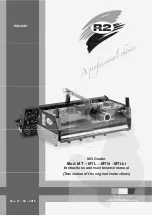
23
multi-line program, decrease the VELOCITY in the next to last line of the program.
Decreasing the VELOCITY will increase the amount of glass left in the last cycle of the
program, thus allowing the glass to attain the trip velocity before separating.
3.5.2.4
TIME Mode (Cooling)
The TIME parameter controls the length of time the cooling air is active (one unit of TIME is
equivalent to 0.5 ms). In order to produce effective cooling, the air must be supplied to the
filament and glass during the time the tip is being formed. When pulling sharp electrodes,
the hard pull lasts several tens of milliseconds. Because of this fact, increasing cooling TIME
values beyond a certain range (typically 200 to 250) will have no effect. Values of TIME under
200 will cool the glass less as the tip is being formed and lead to a longer taper. However, once
TIME values become too short (values in the range 110 to 130) cooling becomes ineffective.
The glass will not form a tip and instead forms a wispy fiber. The very finest tips for a given
PULL and HEAT will be formed at an air setting of about 5 units higher than the lowest
TIME value that forms a tip. Because of this quite narrow working range of usable TIME
values for making micropipettes, it is not recommended to vary cooling, and therefore
electrode tip length, by adjusting TIME. Adjusting the cooling air pressure and/or switching
to the DELAY mode of active cooling are both more effective means of controlling tip length
(see below).
3.5.2.5
Delay Mode (Cooling)
In TIME mode, especially when using larger and or thicker walled glass, active cooling may
not be sufficient to produce short pipette tapers. This may even be true at increased
PRESSURE settings (i.e. >500). In this case, it is recommended that the DELAY mode of
active cooling be used. The method for changing to the DELAY mode is described under
“Software Control Functions” and a brief description of the two modes of cooling is given in
“Programs”.
After switching to DELAY mode, one then has direct control over the delay between turning
the heating filament off and initiating of the hard pull. Because the cooling air is turned on
when the filament is turned off, increasing DELAY profoundly increases glass cooling before
and during the hard pull.
With a range of control over the degree of pipette cooling one can control the rapidity of
pipette taper. Higher DELAY values (longer delay) increase cooling and form a pipette with a
more rapid taper (shorter shank) while lower DELAY values (shorter delay) decrease cooling
and form a pipette with a more gradual taper (longer shank). Fortunately, cooling induced
changes in pipette taper generally occur with little effect on tip size. This is quite valuable as
the resistance of pipettes is a strong function of the length of the taper. By making a pipette
with a sharper taper, one can often decrease pipette resistance significantly without changing
the size of the pipette tip. Furthermore, the ability to control tip length is invaluable for
experiments where long tips are necessary for penetration into deep tissues or where short
stiff tips are necessary for adequate beveling.
Minimum and maximum useable values of DELAY can be expected; their exact values are
dependent on glass thickness and diameter. If DELAY is too short, the glass will not cool
sufficiently to form a tip and a long wispy fiber of glass will be formed. Values under 40 units
tend to be ineffective. At some maximal value of DELAY, the glass may be cooled too much to
separate during the hard pull. Under these conditions, the puller will typically execute
multiple cycles in order to separate the glass and the glass may break at a large tip diameter.
P-97 FLAMING/BROWN MICROPIPETTE PULLER OPERATION MANUAL – REV. 2.43 - DOM (20161118)
Summary of Contents for P-97
Page 3: ......
Page 4: ......
Page 66: ...56 NOTES P 97 FLAMING BROWN MICROPIPETTE PULLER OPERATION MANUAL REV 2 43 DOM 20161118...
















































